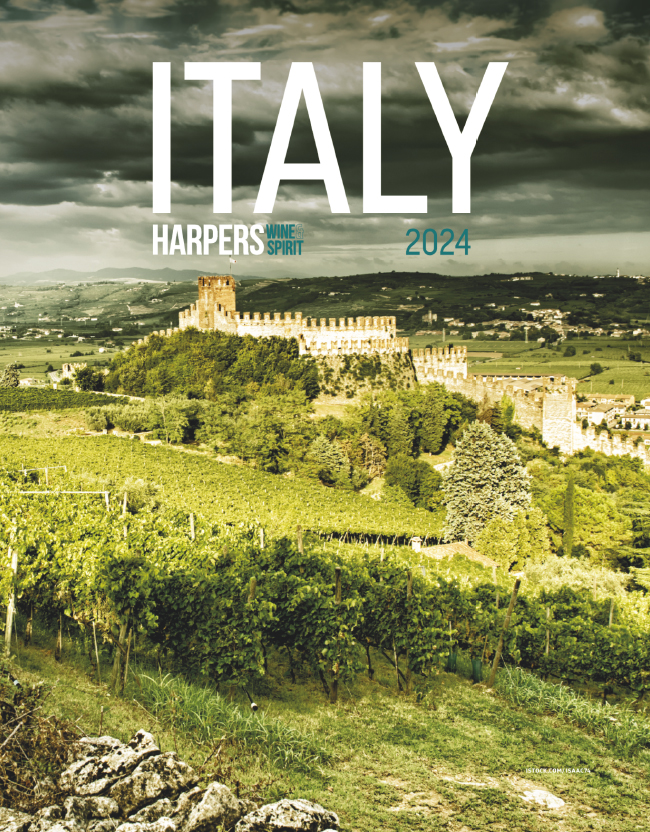CANADA CAN
It's not all about Icewine north of the United States, and much Canadian output is certainly worthy of note. Joanne Simon made the trip; this is what she found
Canada's answer to the Loch Ness Monster is said to live in the dark blue depths of Okanagan Lake, an 82-mile-long stretch of water in the beautiful peaches and beaches' region of British Columbia (BC). Ogopogo, as he is called, is taken even less seriously than his Scottish counterpart, but so dire was the state of the Canadian wine industry in 1981 that Anthony von Mandl might as easily have said he believed in monsters when he bought Mission Hill Family Estate and declared that the Okanagan Valley was on the brink of becoming a wine giant. When I look out over the valley,' he said, I see world-class vinifera vineyards winding their way down the valley; numerous estate wineries, each distinctively different; charming inns and bed-and-breakfast cottages seducing tourists from around the world, while intimate cafes and restaurants captivate the visitor in a magical setting' Apart from one or two other Okanagan visionaries, like Harry McWatters at Sumac Ridge or George Heiss at Gray Monk, the majority of producers - still making a living from sweet hybrid-based products with names like Baby Duck or Gimli Goose - must have thought von Mandl was mad. In fact, it was only in 1989, when a free-trade agreement stripped them of their preferential status in liquor stores, that they ripped out their non-vinifera vineyards (some two thirds of 1,200 hectares/3,000 acres) in order to compete against superior imports. They then confirmed their commitment to quality wine production by adopting Canada's strict Vintner's Quality Alliance (VQA) appellation system in 1991. Today there are more than 50 wineries in the Okanagan, producing 95% of BC's wine (eight million litres) from 5,500 acres. North American wine giant Vincor has driven vineyard investment through its Sumac Ridge, Hawthorn Mountain, Inniskillin and Jackson-Triggs companies, but most wineries are the small, family-run sort of enterprises that tourists love, their products ranging from the experimental, to cult wines like Burrowing Owl (Canada's more modest answer to California's Screaming Eagle). Meanwhile, Nota Bene, the name of Black Hills' delicious and complex Meritage (or Bordeaux-style blend) subtly invites drinkers to take good note' - sound advice that is now relevant for the region as a whole. Von Mandl's dream has come true in a remarkably short time, his $35-million showcase winery providing a stunning symbol for a region rich in fine wine, good food and conviviality. This summer, Bard in the Vineyard performances of A Midsummer Night's Dream in Mission Hill's open-air amphitheatre drew tens of thousands to a region that some say is fast becoming the Napa of the North (although Sonoma might be nearer the mark). The industry has the potential to continue vineyard development, increase national and international sales and create a wine-tourism industry second only to California,' believes BC Wine Institute president Len Bykowski.
In from the cold For those who associate Canada with snow and grizzly bears, the idea that a region so far north can produce decent wine might seem as hard to swallow as the sour whites and stemmy reds that do occasionally still appear. But stretching about 100 miles from south to north, the Okanagan has a unique mesoclimate. Its southern part (from the US border to the town of Okanagan Falls) is the northernmost extension of the Sonoran desert, which reaches all the way into Mexico. Here, along with desert plants that survive on just 6 inches of rain a year, Bordeaux and Rhne varietals thrive (thanks also to amply available irrigation from Okanagan Lake). North of Okanagan Falls, meanwhile, annual rainfall increases to around 16 inches and the lake widens, exerting a greater moderating influence and creating ideal conditions for Germanic and Burgundian grapes. It was the Okanagan's unique desert climate that lured Olivier Combret away from 10 generations of winemaking in Provence to set up Domaine Combret in 1992. There is no better place than the desert to avoid problems with fungal disease,' he explains. And there is some desert in Chile or Washington State, but in my opinion the Okanagan offers more potential in terms of terroir than any other region.' From vines planted on 40 acres of gravel soils on the west side of the valley, Combret produces wines (particularly those under the Saint Vincent label) that are built to age for a long, long time', from high-end Burgundy-style Chardonnay and Pinot Noir, to smoky Cabernet Franc and juicy Gamay. Combret's portfolio also includes Canada's first Gamay Icewine. It is a grape that can do so many things,' he says, and, anyway, I like to experiment!' There are no hard and fast rules in the Okanagan, but winemakers are gradually discovering what works best for them. Let's face it,' says Quail's Gate winemaker Ashley Hooper, on a world scale, nobody's likely to be clamouring for Canadian Cab. On the other hand, there aren't many premium Merlots out there, and that's one thing that does well here. By all means, let's keep making the stuff that sells or is fun to make, so that we don't get bored [Quail's Gate produces about 25 different wine styles, and 40,000 cases in all]. But,' he insists, we have to start focusing on the best we have to offer, which I believe is Merlot and Pinot for the reds and Riesling and Chardonnay for the whites.' Hooper, an Australian who came to Canada three years ago because he didn't want to be just another Aussie making Shiraz', now feels Quail's Gate is in good enough shape for him to head home. I used to have a few qualms about some of our products,' he admits. But now I would be surprised if anyone left our shop unhappy.' For example, low cropping (to under 3 tons an acre) and some time in new oak has helped to transform lacklustre' Gamay into something Hooper feels pretty stoked' about. But Okanagan Pinot Noir is what really gets him excited. For the past two years, our Pinot has gone into 100% new oak and I've never had any comments about the wine being too oaky. Okanagan fruit can handle it, and it results in really complex wines.'
On the edge In contrast, the intensely fruity wines produced at Lang Vineyards don't see any oak. We own one barrel,' laughs Ross Mirko, a veteran Okanagan consultant now happy to be hands-on' at the 8,000-case winery on Naramata Bench, a steep and hilly sub-region on the east side of Okanagan Lake. Lang's herby, meaty Marechal Foch made from 40-year-old vines has built up a good following (750 cases of the 2002 vintage released in April were gone by the end of August), while its true money-spinner is its Canadian Maple Wine, a duty-free hit made by blending neutral white wine with maple syrup (the mind boggles)! But Lang's real stars are its aromatic whites, from citrussy rather than tropical Gewurztraminer, to rich, apricotty, late-harvest Riesling. As for that one oak barrel? It turns out that a bright, peachy 2002 Viognier was one-third barrel-fermented. I'm very curious to see where this wine goes in a couple of years,' says Mirko - and he doesn't mean into which export market, since most of the outstanding wines produced along the Naramata Bench never make it out of the region. Red Rooster, for example, produces about 10,000 cases, of which most is sold ex-cellar door or directly to restaurants and speciality wine stores. Small amounts are also exported to owners Beat and Prudence Mahrer's native Switzerland, including precious few bottles of The Golden Egg, a handcrafted wine (with a cult following) that undeniably proves Canada's ability to produce serious, high-end Bordeaux-style reds. There is no shortage of wines in the world,' says Mahrer, but I think we have something very special and truly unique to offer due to our climate.' Nonetheless (since we're on the subject of climate), this is extreme winemaking. The winters are bitterly cold - if not cold enough every year to guarantee production of Icewine, Canada's flagship stickie (in fact, many Okanagan dessert-wine producers are shifting their focus away from Icewine to produce beautifully concentrated Late Harvest wines instead). Meanwhile, the 2002 vintage may have been one of BC's best on record, with 2003 - the driest summer in 74 years - appearing to shape up the same way. But a lightning strike on 16 August sparked a fire that eventually destroyed over 250 houses in the Kelowna area. The wine industry got off lightly, all things considered, except for the production facilities and one family home at St Hubertus Estate Winery - cruel irony for Swiss-born co-owner Andy Gebert, who had told me just two days prior to the fire that he strongly believed in working with nature, not against it' and even wished to take the logical next step' from organic to biodynamic viticulture. St Hubertus is not certified organic (I took one look at all the paperwork required and decided, oh, let's save that tree!'), but then neither does it offer an old vines' label despite having Riesling that dates from 1978.
What next? Overall, I left the Okanagan Valley in awe of its beauty, impressed by white wines with mouthwatering acidity and concentrated fruit flavours (up a notch even from those found in Washington) and expecting great - even thrilling - things in the future from reds that are already balanced and elegant. What's more, there are real bargains to be found, as Ingo Grady, Mission Hill's director of trade development, sums up: Our wines don't have the privilege of coming from a recognised wine region, so they still have to overdeliver.' It seems the question is not so much whether the Okanagan has the potential to join, say, the Columbia and Willamette Valleys as a world-class wine region, but rather why it has taken so long to do so. The Okanagan is a sleeping giant,' believes Olivier Combret. From my French perspective, I think it is because Canada is not a wine country. There is no tradition of drinking wine, let alone making it, and we still have to fight against a kind of Prohibitionist thinking. For example,' he elaborates, if you have a wine business and want to attract tourists, the local authorities are much more flexible across the border in Washington State. Here, it is really hard for wineries to get a licence to offer a bite to eat because you first have to prove that local restaurants will not lose any business.' Unlike Europe, with its cathedrals, or even the rival' Canadian wine region of Niagara Peninsula in Ontario, with the Niagara Falls in spitting distance, Combret points out that wine is now the primary reason for people to visit the Okanagan. It is obvious that food-and-wine pairing will attract a bigger flow of tourists, and slowly but surely we are convincing our authorities. Anyway, one thing I've learnt', he winks, is that it's easier to ask for forgiveness than permission.'







